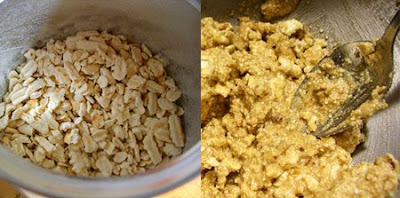 You are gonna love these balls.
You are gonna love these balls.
This week, in my ongoing Jewish-American cooking project, Ilana and I are attempting Featherballs:

Featherballs are essentially matzo balls, but are unique in the fact that they are flavored with nutmeg or ginger. My friend and cohort Ilana pointed out that ordinarily in matzo ball soup, it’s the broth that is the most flavorful, and the matzo balls added as filler. In this recipe, the flavor of the matzo balls are brought to the forefront. Additionally, these balls do have a light and fluffy texture–but we’ll get to that in moment.
I journeyed to Brooklyn to meet with Ilana and her boyfriend Jed, for a lesson in Matzo balls. They filled me in on some matzo ball facts: That they were normally made with butter or margarine, so they anticipated this recipe to be much richer, and possibly heavier. Additionally,
 most New York matzo balls are fist-size, like the ones you’ll find at Katz’s or the 4th Ave. Deli. These featherballs were to be rolled the size of walnuts. Their are also two types of matzo balls–the light “floaters” and the dense “sinkers.” Neither are wrong, just a personal preference.
most New York matzo balls are fist-size, like the ones you’ll find at Katz’s or the 4th Ave. Deli. These featherballs were to be rolled the size of walnuts. Their are also two types of matzo balls–the light “floaters” and the dense “sinkers.” Neither are wrong, just a personal preference.We whipped the eggs and the schmaltz until each were fluffy, then combined them and added the dry ingredients. We split the dough between two bowls, and flavored half with nutmeg, and half with ginger. The dry ingredients were added, and mixed by hand until just combined. Jed warned us that over mixing the ingredients would result in a matzo ball as hard as rock.
Jed also said that with most matzo ball recipe, you let the batter chill first, and then roll the balls. In the recipe, you roll first and then chill. We shrugged and followed the recipe.
While the matzo balls chilled in the fridge, Jed cooked some carrot slices in chicken broth. We used boxed broth, but one of the cool things about this recipe is it written for a home cooked soup: you would make you soup, skim the chicken fat off the top, add the fat to the matzo balls, and cook the balls in the soup. Jed also noted that the carrots are essential; they help to break up the saltiness of the broth and the matzo, and gives your palette a rest.
 The featherballs are dropped into boiling chicken broth.
The featherballs are dropped into boiling chicken broth.When the broth came to a rolling boil, we dropped the featherballs in and covered the pot. 18 minutes later they were done. Be careful not to cook them too long–they begin to fall apart in the water. Some may be a little underdone in the middle, which is fine. We turned off the burner and served us up a bowl of featherballs.
I have to admit, I have no basis of comparison, these being perhaps the second matzo balls I’ve had in my life. But I did think they were really good. Jed and Ilana have grown up on matzo. The three of us agreed the texture was great–Jed and Ilana said much less dense than an ordinary matzo ball. It was light, but also very hearty. After eating four, we were full.
We couldn’y taste the ginger in the featherballs, although they were still salty and good. The nutmeg taste was present, and they were deigned the favorites by Jed and Ilana. For me, it was hard. I associate the taste of nutmeg with dense cakes of the 1850s, and it was difficult to get out of the mindset. We speculate that mace (the spicy out shell of a nutmeg) might also make a good featherball.
The featherballs were really perfect. Ilana hit the nail on the head: “These are the best matzo balls I’ve ever had. I think we’ve really rediscovered something.”
In the coming weeks, we plan on doing one more Jewish cooking day based on our Manischewitz cookbook. Ilana and Jef will handle savory dishes (pumpkin pancakes, tamales, asparagus wheel) and I’ll attack sweets (boston pie, orient cake, farfelroons). I will keep you updated as to our progress.






